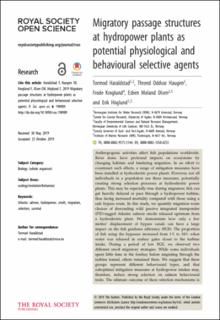| dc.contributor.author | Haraldstad, Tormod | |
| dc.contributor.author | Haugen, Thrond Oddvar | |
| dc.contributor.author | Kroglund, Frode | |
| dc.contributor.author | Olsen, Esben Moland | |
| dc.contributor.author | Höglund, Erik | |
| dc.date.accessioned | 2020-07-08T11:12:32Z | |
| dc.date.available | 2020-07-08T11:12:32Z | |
| dc.date.created | 2020-02-13T13:46:01Z | |
| dc.date.issued | 2019 | |
| dc.identifier.citation | Royal Society Open Science. 2019, 6 (11), 190989. | en_US |
| dc.identifier.issn | 2054-5703 | |
| dc.identifier.uri | https://hdl.handle.net/11250/2661405 | |
| dc.language.iso | eng | en_US |
| dc.publisher | Royal Society | en_US |
| dc.rights | Navngivelse 4.0 Internasjonal | * |
| dc.rights.uri | http://creativecommons.org/licenses/by/4.0/deed.no | * |
| dc.title | Migratory passage structures at hydropower plants as potential physiological and behavioural selective agents | en_US |
| dc.type | Peer reviewed | en_US |
| dc.type | Journal article | en_US |
| dc.description.version | publishedVersion | en_US |
| dc.rights.holder | Anthropogenic activities affect fish populations worldwide. River dams have profound impacts on ecosystems by changing habitats and hindering migration. In an effort to counteract such effects, a range of mitigation measures have been installed at hydroelectric power plants. However, not all individuals in a population use these measures, potentially creating strong selection processes at hydroelectric power plants. This may be especially true during migration; fish can get heavily delayed or pass through a hydropower turbine, thus facing increased mortality compared with those using a safe bypass route. In this study, we quantify migration route choices of descending wild passive integrated transponder (PIT)-tagged Atlantic salmon smolts released upstream from a hydroelectric plant. We demonstrate how only a few metres’ displacement of bypass canals can have a large impact on the fish guidance efficiency (FGE). The proportion of fish using the bypasses increased from 1% to 34% when water was released in surface gates closer to the turbine intake. During a period of low FGE, we observed two different smolt migratory strategies. While some individuals spent little time in the forebay before migrating through the turbine tunnel, others remained there. We suggest that these groups represent different behavioural types, and that suboptimal mitigation measures at hydropower intakes may, therefore, induce strong selection on salmon behavioural traits. The ultimate outcome of these selection mechanisms is discussed in light of potential trade-offs between turbine migration mortality coast and optimal sea entrance timing survival benefits. | en_US |
| dc.source.pagenumber | 12 | en_US |
| dc.source.volume | 6 | en_US |
| dc.source.journal | Royal Society Open Science | en_US |
| dc.source.issue | 11 | en_US |
| dc.identifier.doi | 10.1098/rsos.190989 | |
| dc.identifier.cristin | 1793867 | |
| cristin.unitcode | 7464,0,0,0 | |
| cristin.unitname | Norsk institutt for vannforskning | |
| cristin.ispublished | true | |
| cristin.fulltext | original | |
| cristin.qualitycode | 1 | |

